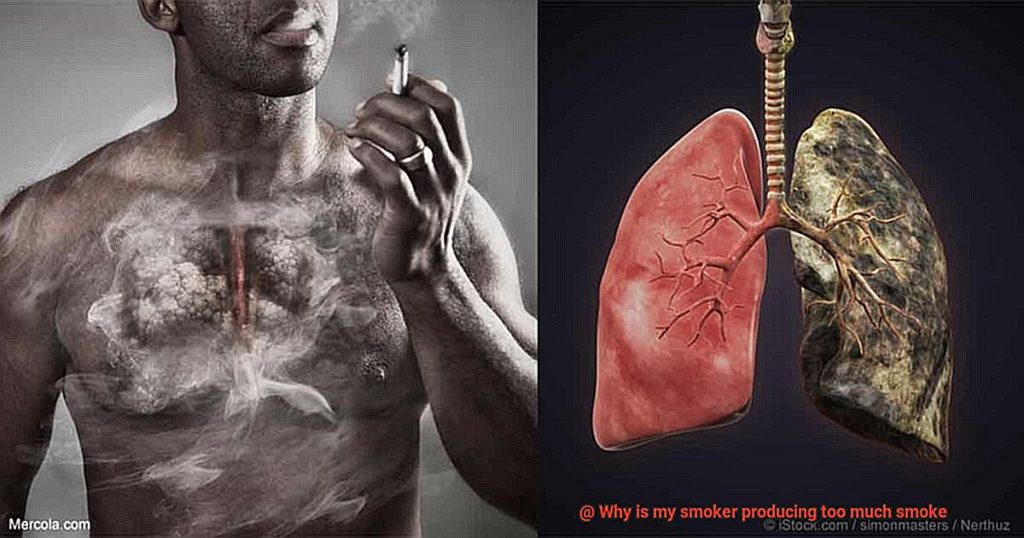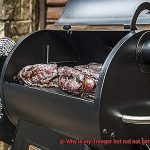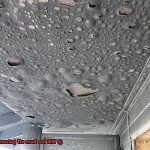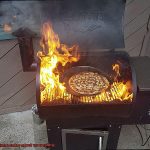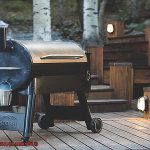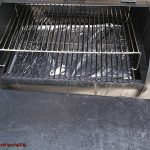Ready to fire up the smoker and get your BBQ game on, only to find that it’s spewing out more smoke than a chimney? Don’t worry, you’re not alone in this. While a good amount of smoke is essential for that delectable smoky flavor we all love, too much of it can ruin the taste and texture of your meat.
But what causes an excess of smoke? Poor ventilation, using the wrong wood type, or simply using too much wood are some common culprits. The result is dense smoke that leaves a bitter aftertaste and even a layer of creosote on your meat.
Don’t let your summer BBQ plans go up in flames. In this blog post, we’ll dive into the reasons why your smoker is producing too much smoke and how to fix it. From discussing different types of wood and their impact on smoke output to addressing ventilation issues and finding the right amount of wood to use – we’ve got you covered.
With these tips in hand, you’ll be able to identify the problem and make necessary adjustments for perfectly smoked meat. Say goodbye to excessive smoke and hello to mouth-watering BBQ like never before.
Contents
What Causes Too Much Smoke in a Smoker?
As a connoisseur of smoked meats, there’s nothing quite as frustrating as a smoker that produces an excessive amount of smoke. Not only does it ruin the flavor of your meat, but it can also be unsafe to consume. Fortunately, there are several reasons why this might be happening, and even easier solutions to fix it.
One of the most common culprits of too much smoke in a smoker is wet wood chips or chunks. If your wood hasn’t been stored properly or isn’t completely dry before being added to the smoker, it will produce more smoke and less heat. This causes an imbalance in the smoker’s temperature, leading to an unpleasant amount of smoke.
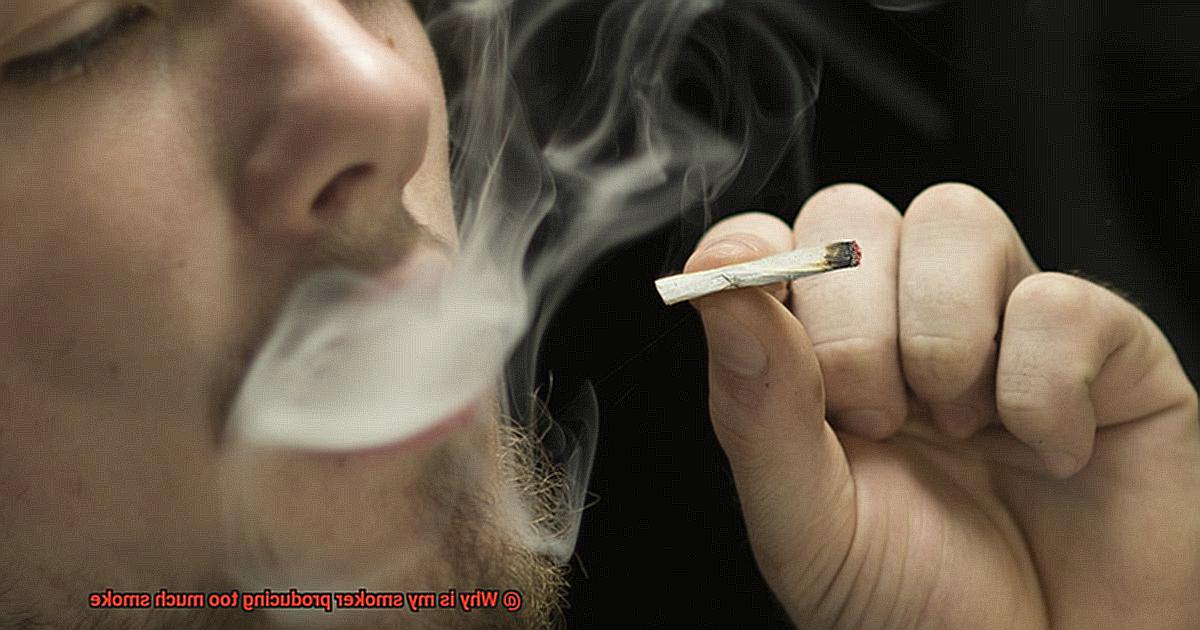
Another reason for excess smoke production is poor ventilation. It’s essential to ensure that there is adequate air circulation throughout your smoker, so keep all vents open when smoking. If the vents are closed or there’s not enough space between the food and the lid, smoke can build up and become trapped inside the smoker.
Overloading your smoker with too much meat or wood can also cause excessive smoke production. Follow the manufacturer’s instructions carefully regarding how much meat and wood you should use in your smoker.
Lastly, using the wrong type of wood can contribute to excessive smoke production in a smoker. Some woods are better suited for smoking than others, so it’s important to read the manufacturer’s instructions carefully and use the recommended type of wood for your smoker.
Using the Wrong Type of Wood Chips or Pellets
One of the most common mistakes is using the wrong type of wood chips or pellets in your smoker. As an expert on this topic, I’m here to share some tips to help you choose the right type of wood and achieve perfectly smoked meats every time.
Firstly, it’s important to understand that each type of wood has its unique flavor and burning properties. Hickory and mesquite are more potent and can quickly overpower meat if used in excess. On the other hand, fruitwoods like apple and cherry have a milder flavor and are better suited for lighter meats like chicken and fish. It’s essential to choose the right type of wood to complement your meat’s flavor profile and avoid overwhelming it.
In addition to choosing the right type of wood, it’s crucial to use high-quality wood chips or pellets. Cheaper options may contain additives or chemicals that can affect the taste of your food. Always read the package label and look for 100% natural options to ensure optimal flavor.
Another important factor is soaking your wood chips in water before using them in your smoker. Soaking helps to slow down the burning process, preventing excessive smoke production. However, be careful not to oversoak your wood chips as they may not burn properly, leading to a lack of smoke production.
To summarize, here are some tips to ensure perfectly smoked meats:
- Choose the right type of wood to complement your meat’s flavor profile
- Use high-quality, 100% natural wood chips or pellets
- Soak your wood chips just enough to ensure optimal smoke production
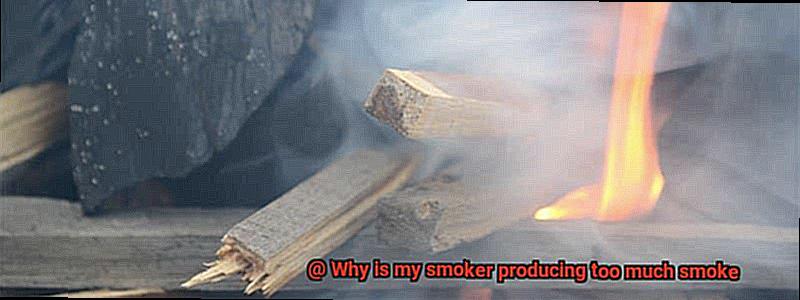
Poor Ventilation
Well, poor ventilation could be the culprit. As an expert on all things smoking, I’m here to share some tips on how to avoid poor ventilation and achieve the perfect smoke.
Poor ventilation is one of the most common reasons why smokers produce too much smoke. When there is not enough air flowing through the smoker, the wood chips or pellets won’t burn as efficiently, resulting in excessive smoke. This can happen when the smoker’s vents are blocked or closed, or when the smoker is located in an area with little to no air circulation.
So, what can you do to avoid poor ventilation? Here are a few tips:
- Make sure that your smoker’s vents are open and unobstructed. This will allow air to flow through your smoker and prevent excessive smoke from building up.
- Pay attention to where you’re positioning your smoker. If it’s in an area with poor airflow, consider moving it somewhere else or using a fan to increase circulation.
- If you’re using a charcoal smoker, make sure that you don’t over-pack the charcoal. Overloading the charcoal can lead to poor ventilation and excessive smoke production. Instead, use the recommended amount of charcoal for your smoker and adjust as needed.
- Consider upgrading your smoker to a model with better ventilation. Some smokers come with adjustable vents that allow you to control the airflow and smoke production, which can be helpful in avoiding excessive smoke.
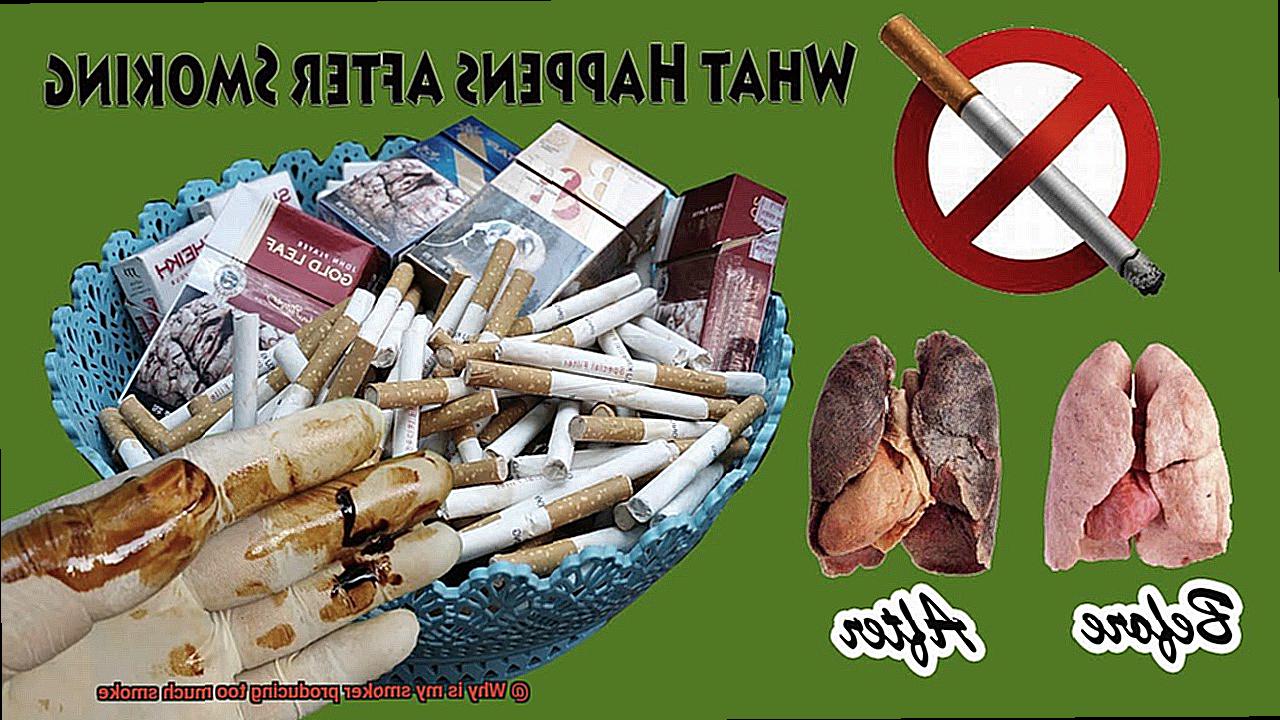
Remember, poor ventilation can have a significant impact on your smoking experience. By keeping your vents open and unobstructed, positioning your smoker in an area with good airflow, and using the right amount of charcoal, you can avoid producing too much smoke and achieve delicious smoked meats every time.
Using Wet Wood Chips or Pellets
While it may seem like a simple task, it can be easy to produce too much smoke which can ruin your meat’s flavor. But don’t worry, with these tips, you’ll be able to achieve just the right amount of smoky goodness.
Firstly, it’s important to note that wet wood produces more smoke than dry wood. This is because the water in the wood evaporates and creates steam which mixes with the smoke, resulting in a thicker, heavier smoke. However, this doesn’t mean you should avoid wet wood altogether. Instead, soak your wood chips or pellets for no more than 30 minutes before using them in the smoker to allow them to absorb enough moisture to produce smoke without creating an excessive amount.

Secondly, not all types of wood are suitable for smoking. Softwoods like pine or spruce contain high levels of resin that can produce toxic smoke when burned. Stick to hardwoods like oak, hickory, cherry, or apple for a milder and sweeter flavor.
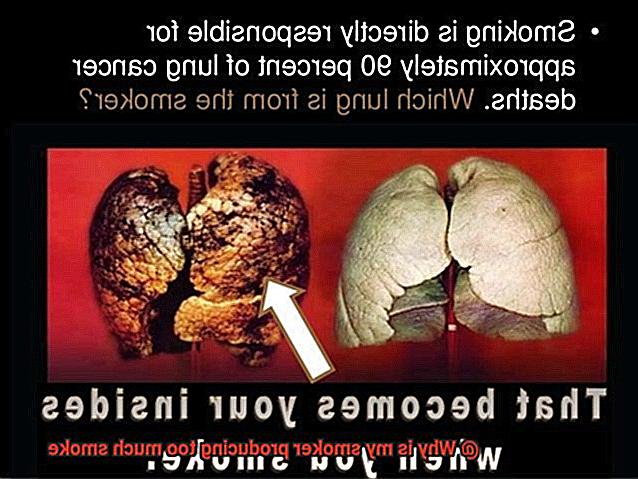
Thirdly, the temperature of your smoker is crucial in controlling the amount of smoke produced. If the smoker temperature is too low, it can cause incomplete combustion of the wood and result in more smoke being produced. Maintaining a consistent temperature is key to ensure proper combustion of the wood and prevent excess smoke.
Finally, moderation is key when using wet wood chips or pellets in your smoker. Using too much wet wood can create an excessive amount of smoke and overpower your meat’s flavor. So use them properly and in moderation to achieve just the right amount of smokiness.
Overloading Your Smoker
Before you start loading up your smoker with wood or charcoal, let’s talk about overloading. This common mistake can lead to too much smoke and inconsistent temperature control, resulting in an overpowering smoky flavor and potentially ruined meat.
Let’s break it down:
Too Much Smoke
Overloading your smoker with fuel can cause the fire to burn too hot and create more smoke than necessary. This can result in an overpowering smoky flavor that can ruin the taste of your meat. Moreover, too much smoke can be harmful to your health.
Inconsistent Temperature Control
Overloading your smoker can also lead to inconsistent temperature control. When you have too much fuel in your smoker, it can be challenging to maintain a consistent temperature throughout the smoking process. This can result in overcooked or undercooked food, which nobody wants.
How to Prevent Overloading
To avoid overloading your smoker, use the appropriate amount of fuel for the size of your smoker and the amount of food you’re cooking. Take care to monitor the temperature inside your smoker regularly and adjust the fuel as needed to maintain a consistent temperature.
Consider using wood chips or chunks instead of logs since they burn more quickly and cleanly, which can help maintain better temperature control and produce less smoke.
Remember that smoking is a slow and steady process that requires patience and attention to detail. Properly loading and monitoring your smoker is essential to producing delicious, perfectly smoked meats without producing too much smoke.
The Impact of Excessive Smoke on Meat Quality
While the aroma of smoke can be tantalizing, excessive smoke can have an adverse impact on the quality of your meat. As an expert in this field, I can enlighten you on how too much smoke can ruin your meat and provide evidence-backed tips to avoid these consequences.
Firstly, let’s dive into the taste of the meat. When exposed to excessive smoke, your meat may become bitter and overly smoky in flavor. Strong woods such as mesquite or hickory produce a lot of smoke, and overuse can lead to this problem. Therefore, if you notice that your meat tastes too smoky or bitter, it is likely that you are using too much wood or smoking for too long.
Secondly, excessive smoke can cause your meat to become dry and tough. Smoke consists of chemicals that break down the proteins in the meat, causing it to lose moisture and tenderness. Over-smoking or overusing wood will result in dry and overcooked meat.
To avoid these issues, it is crucial to use the right amount of wood and smoke for your smoker and type of meat. Different woods produce varying levels of smoke, so experimentation is key to find what works best for you. Additionally, monitoring the temperature and cooking time carefully ensures that your meat comes out perfectly smoked without being overly smoky or dry.
Here are some sub-topics to consider when smoking meat:
- The type of wood used
- The amount of smoke produced
- The length of time the meat is exposed to smoke
- Temperature and cooking time
- Experimentation with different woods
Tips for Controlling Smoke Production in a Smoker
If you’re a fan of smoking meat, you know that achieving the perfect smoky flavor is essential. However, too much smoke can ruin your meal and leave an unpleasant taste in your mouth. To prevent this, here are some tips on how to control smoke production in your smoker.
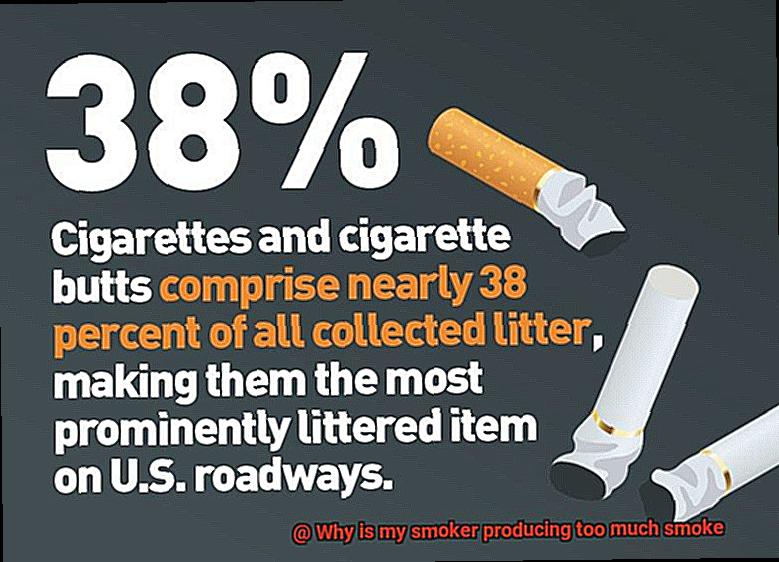
Choose the Right Wood
The type of wood you use in your smoker can affect the amount of smoke produced. Hardwoods like oak and mesquite produce more smoke, while fruitwoods like apple and cherry produce milder smoke. Experiment with different woods to find the right balance for your taste.
Soak Your Wood Chips
Soaking your wood chips in water for at least 30 minutes before adding them to your smoker can help regulate temperature and reduce the amount of smoke produced. Soaked wood chips produce steam, which helps maintain consistent temperature and control smoke production.
Control Airflow
Airflow is crucial for regulating temperature and controlling smoke production. Adjusting vents or dampers can help regulate temperature, which in turn affects smoke production. A good rule of thumb is to start with partially open vents and adjust them as needed throughout the smoking process.
Use a Water Pan
Adding a water pan to your smoker can help regulate temperature and prevent flare-ups caused by excessive smoke production. The water pan also helps keep meat moist, resulting in a juicier final product.
Keep Your Smoker Clean
Excess buildup of ash and soot in your smoker can affect airflow and increase smoke production. Regular cleaning of your smoker’s grates, interior, and chimney can help reduce excess smoke production. Make sure to clean out ash and debris from the smoker regularly to prevent issues with air circulation.
iaKwEQHuFqg” >
Conclusion
In conclusion, excessive smoke production in your smoker can be a recipe for disaster when it comes to flavor and texture. But fear not, with the right knowledge and adjustments, you can achieve perfectly smoked meats every time. Poor ventilation, using the wrong type or too much wood, and wet chips or pellets are common culprits of excessive smoke production.
To avoid these issues, choosing the right type of wood for your meat’s flavor profile is essential. Using high-quality natural wood chips or pellets and soaking them just enough to ensure optimal smoke production will also help. Additionally, maintaining proper ventilation by keeping vents open and unobstructed, positioning your smoker in an area with good airflow, and using the right amount of charcoal are crucial factors in controlling smoke production.
Overloading your smoker with too much fuel can lead to inconsistent temperature control and excessive smoke. This negatively impacts the taste and texture of your meat by making it bitter or dry. Experimentation with different woods, monitoring temperature and cooking time carefully, and regular cleaning of your smoker can help prevent these issues.
By following these tips for controlling smoke production in a smoker, you’ll be able to achieve mouth-watering BBQ without ruining the taste of your meat.

